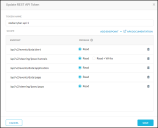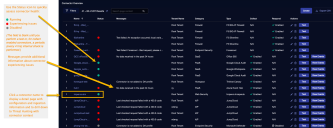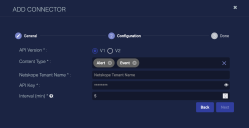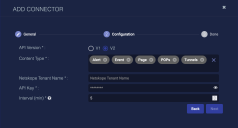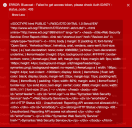Configuring Netskope Connectors
This connector allows Stellar Cyber to collect data from external sources and add the records to the data lake.
Netskope integration with Stellar Cyber enables organizations to monitor and protect their cloud environment, providing real-time threat intelligence and automated response workflows to improve incident response and threat mitigation.
There can be any number of Netskope connectors active.
Stellar Cyber connectors with the Collect function (collectors) may skip collecting some data when the ingestion volume is large, which potentially can lead to data loss. This can happen when the processing capacity of the collector is exceeded.
Connector Overview: Netskope
Capabilities
-
Collect: Yes
-
Respond: No
-
Native Alerts Mapped: No
-
Runs on: DP
-
Interval: Configurable
Collected Data
|
Content Type |
Index |
Locating Records |
|---|---|---|
|
Alert Event Page Pops Tunnels |
Syslog
|
Domain
|
https://<Netskope Tenant Name>.goskope.com where <Netskope Tenant Name> is a variable from the configuration of this connector |
Response Actions
N/A
Third Party Native Alert Integration Details
N/A
Required Credentials
-
Netskope Tenant Name and API Key
Let us know if you find the above overview useful.
Adding a Netskope Connector
To add a Netskope connector:
- Obtain your Netskope credentials
- Add the connector in Stellar Cyber
- Test the connector
- Verify ingestion
Obtaining your Netskope Credentials
Before you configure the connector in Stellar Cyber, you must obtain an API token from Netskope.
-
Log in as an administrative user to the Netskope Admin Console, for example: https://netskope-tech.okta.com/app/UserHome.
-
Choose Settings.
-
Choose Tools.
-
Choose REST API v2 to get an API token for all the available content types. (Or, you can choose REST API v1 to get an API token for the Alert and Event content types only.) Then choose NEW TOKEN.
To select the Netskope API version that you want the connector to use, refer to the following information as a guide for selecting your Netskope endpoints. This selection must correspond to the version associated with the API token:
V1: For this version, the following endpoints are supported:
-
/api/v2/events/data/alert (supports data types: policy, dlp, watchlist)
-
/ api/v2/events/data/application (supports data type: application)
V2: For this version, the following endpoints are supported:
-
/api/v2/events/data/alert (supports data types: policy, dlp, watchlist)
-
/ api/v2/events/data/application (supports data type: application)
-
/api/v2/events/data/page (supports data type: page)


-
/api/v2/steering/ipsec/pops (supports data type: pops)


-
/api/v2/steering/ipsec/tunnels (supports data type: tunnels)


-
-
Select the privilege for the endpoints you want to select. At a minimum, select Read.
For example, for REST API v2:

For example, for REST API v1:
-
Click Save.
Adding the Connector in Stellar Cyber
With the configuration information handy, you can add the Netskope connector in Stellar Cyber:
-
Log in to Stellar Cyber.
-
Click System | Integration | Connectors. The Connector Overview appears.
-
Click Create. The General tab of the Add Connector screen appears. The information on this tab cannot be changed after you add the connector.
The asterisk (*) indicates a required field.
-
Choose Web Security from the Category drop-down.
-
Choose Netskope from the Type drop-down.
-
For this connector, the supported Function is Collect, which is enabled already.
-
Enter a Name. This field is required, and does not accept multibyte characters.
-
Choose a Tenant Name.
This field does not accept multibyte characters.
-
Choose the device on which to run the connector.
-
(Optional) When the Function is Collect, you can create Log Filters. For information, see Managing Log Filters.

-
Click Next. The Configuration tab appears.
-
Select the Netskope API Version that you want the connector to use.
If the selected API Version is V1, the Configuration tab is as follows:
The asterisk (*) indicates a required field.
If the selected API Version is V2, the Configuration tab is as follows:


The asterisk (*) indicates a required field.
-
Choose the Content Type you would like to collect. For V1, the logs for Alert and Event are supported. For V2, the logs for Alert, Event, Page, Pops, and Tunnels are supported.


-
Enter the Netskope Tenant Name, for example, companya.
Do not enter a full URL, for example, companya.goskope.com.
-
Enter the API Key you noted above in Obtaining your Netskope Credentials.
-
Choose the Interval (min). This is how often the logs are collected. The default interval is 5 minutes.
Pops and Tunnels information is queried every 24 hours.
-
Choose the Interval (min). This is how often the logs are collected.
-
Click Next. The final confirmation tab appears.
-
Click Submit.
To pull data, a connector must be added to a Data Analyzer profile if it is running on the Data Processor.
The new connector is immediately active.
Testing the Connector
When you add (or edit) a connector, we recommend that you run a test to validate the connectivity parameters you entered. (The test validates only the authentication / connectivity; it does not validate data flow).
For connectors running on a sensor, Stellar Cyber recommends that you allow 30-60 seconds for new or modified configuration details to be propagated to the sensor before performing a test.
-
Click System | Integrations | Connectors. The Connector Overview appears.
-
Locate the connector that you added, or modified, or that you want to test.
-
Click Test at the right side of that row. The test runs immediately.
Note that you may run only one test at a time.
Stellar Cyber conducts a basic connectivity test for the connector and reports a success or failure result. A successful test indicates that you entered all of the connector information correctly.
To aid troubleshooting your connector, the dialog remains open until you explicitly close it by using the X button. If the test fails, you can select the button from the same row to review and correct issues.
The connector status is updated every five (5) minutes. A successful test clears the connector status, but if issues persist, the status reverts to failed after a minute.
Repeat the test as needed.
Verifying Ingestion
To verify ingestion:
- Click Investigate | Threat Hunting. The Interflow Search tab appears.
- Change the Indices to Syslog. The table immediately updates to show ingested Interflow records.



